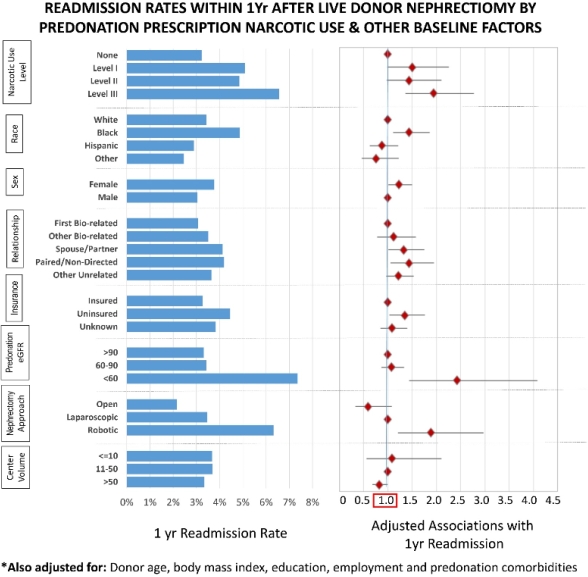Predonation Prescription Narcotic Use: A Novel Risk Factor for Readmission After Living Donor Nephrectomy.
1Scientific Registry of Transplant Recipients, Minneapolis
2Johns Hopkins, Baltimore
3Dartmouth, Hanover
4Univ Alberta, Alberta, Canada
5Western Univ, London, Canada
6Symphony Health, Pittsburgh
7Saint Louis Univ, St. Louis.
Meeting: 2016 American Transplant Congress
Abstract number: 536
Keywords: Donation, Outcome, Pain, Post-operative complications
Session Information
Session Name: Concurrent Session: Living Kidney Donor Evaluation
Session Type: Concurrent Session
Date: Tuesday, June 14, 2016
Session Time: 4:30pm-6:00pm
 Presentation Time: 5:30pm-5:42pm
Presentation Time: 5:30pm-5:42pm
Location: Ballroom B
Implications of narcotic use in living kidney donor (LKD) candidates for key outcomes, including readmission rates after nephrectomy, are unknown.
We integrated 1) national Scientific Registry of Transplant Recipients data with 2) pharmacy fill records from a nationwide pharmacy claims clearinghouse, and 3) administrative records from an academic hospital consortium (98 centers, 2008-2012) to quantify predonation prescription narcotic use and postdonation readmission events. Narcotic fills in the yr before donation were normalized to morphine equivalents. Associations of predonation narcotic use (adjusted odds ratio, aOR) and other baseline clinical, procedural, and center factors with readmission within 1 yr postdonation were examined using multivariate logistic regression.
Among 14,959 LKD, 11.2% filled ≥1 narcotic prescription in the yr before donation; 3.6% were readmitted within 1 yr postdonation. LKD with the highest predonation narcotic use were more likely to be readmitted (aOR 1.94, 95% CI 1.36-2.77, P=0.0002) than non-users (Figure). Adjusted readmission risk was significantly (P<0.05) higher for African Americans (aOR 1.44), women (aOR 1.23), exchange participants (aOR 1.44), uninsured LKD (aOR 1.35), LKD with predonation eGFR<60 (aOR 2.43), and after robotic nephrectomy (aOR 1.89). LKD at high-volume centers had lower readmission rates (aOR 0.82). LKD who used narcotics predonation were more likely to fill narcotics late in yr 1 postdonation (aOR 8.71, P<0.0001 for fills in days 275-365).

Predonation narcotic use is independently associated with increased readmission risk after living donor nephrectomy. Future work should identify underlying mechanisms and approaches to improving postdonation outcomes.
CITATION INFORMATION: Lentine K, Segev D, Axelrod D, Lam N, Garg A, Hess G, Kasiske B, Brennan D, Randall H, Schnitzler M. Predonation Prescription Narcotic Use: A Novel Risk Factor for Readmission After Living Donor Nephrectomy. Am J Transplant. 2016;16 (suppl 3).
To cite this abstract in AMA style:
Lentine K, Segev D, Axelrod D, Lam N, Garg A, Hess G, Kasiske B, Brennan D, Randall H, Schnitzler M. Predonation Prescription Narcotic Use: A Novel Risk Factor for Readmission After Living Donor Nephrectomy. [abstract]. Am J Transplant. 2016; 16 (suppl 3). https://atcmeetingabstracts.com/abstract/predonation-prescription-narcotic-use-a-novel-risk-factor-for-readmission-after-living-donor-nephrectomy/. Accessed December 31, 2025.« Back to 2016 American Transplant Congress
